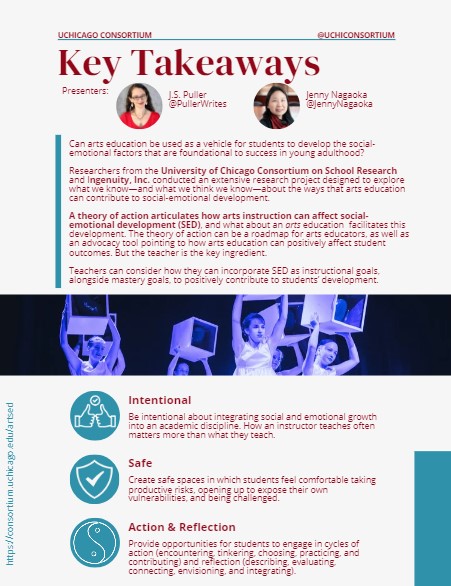1. What kind of theory of action describes the role arts education can play in children's social-emotional development?
2. What mechanisms of arts education can affect social-emotional competencies?
Social and emotional learning is a topic of increasing focus in the education sector. Though definitions and terminology vary, at its core this trend reflects an increased interest among educators, administrators, parents, and other stakeholders in students’ development of individual and interpersonal skills beyond the realm of academic achievement.
This project, conducted in partnership with Ingenuity, consists of two components: a review of literature on this topic and an interview-based fieldwork component with educators, administrators, students, and parents in Chicago Public Schools. The authors reviewed more than 200 studies on arts education spanning six decades. They also conducted focus groups and interviews with key participants in the arts education process—including educators, administrators, students, and parents—to evaluate evidence of the effects of arts education on social-emotional development in school and after-school settings. They found a widespread belief that arts education contributes to children’s and adolescents’ social-emotional development. Specifically that:
- Exposure to arts opportunities allows students and teachers to engage with one another in a way that often stands in contrast to how they engage with each other in the context of regular academic instruction and that provides rich opportunities for social-emotional learning.
- Arts education has social-emotional effects regardless of instructor intent—and these effects can be either positive or negative. Though arts education can be a powerful force in supporting students’ social-emotional development, the report’s findings caution educators to be intentional in the social-emotional contexts they create through their lessons to, as much as possible, promote positive interactions and help students process challenges and disappointments so they don’t end up feeling alienated or ashamed by their arts experiences.
Developmental experiences are at the core of social-emotional learning, and while the arts tend to lead in this regard—providing opportunities for young people to engage in experiences—educators at large could explore ways to translate arts education strategies to their own classrooms.
Key Takeaways for Educators
- Be intentional about integrating social and emotional growth into an academic discipline. How an instructor teaches often matters more than what they teach.
- Create safe spaces in which students feel comfortable taking productive risks, opening up to expose their own vulnerabilities, and being challenged.
- Provide opportunities for students to engage in cycles of action (encountering, tinkering, choosing, practicing, and contributing) and reflection (describing, evaluating, connecting, envisioning, and integrating).
Click below to view a 90-second episode of GO FIGURE, with J.S. Puller explaining Figure 3 of this research (September 12, 2023).
Click below to view a 90-second episode of GO FIGURE, with J.S. Puller explaining Figure 4 of this research (September 9, 2025).




